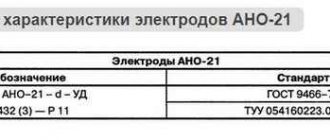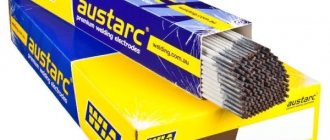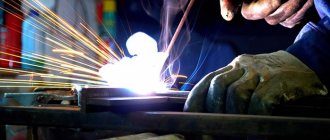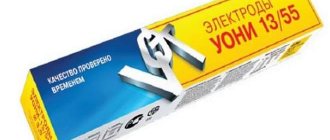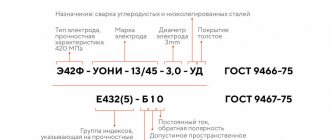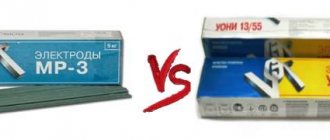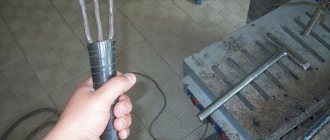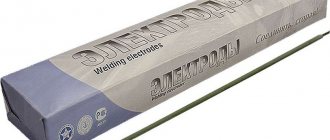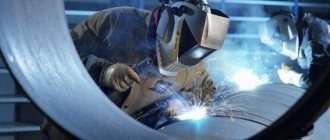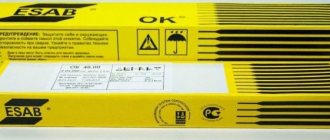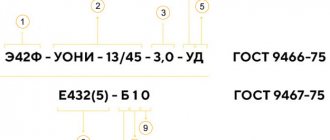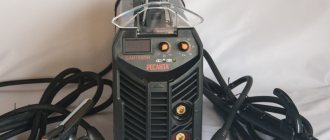The modern market offers many types of electrodes for performing various welding jobs. Many of them are divided by the type of current used, which is very convenient for both manufacturers and craftsmen. Therefore, most welders use DC and AC electrodes. In this article we will tell you in detail which electrodes are better for welding using alternating current and how DC electrodes differ from alternating current electrodes.
Marking, decoding
ANO-3 marking means:
- A - Academy;
- N - Sciences;
- O - coated;
- 3 - development model.
E46-ANO-3-d-UD E 432(3)-R24, where:
- E46 – type of electrode, suitable for low-alloy steels with low tensile strength;
- ANO-3 – brand;
- d – diameter;
- U – compound of carbon alloys;
- D – with thickened coating;
- E – international designation of a consumable coated electrode;
- tensile strength – 43 – 430 MPa;
- relative elongation – 2 – 22%;
- the minimum temperature at which the impact strength of the weld metal is at least 34 J/cm2 – 3 – -20°C;
- type of coating – R – rutile;
- spatial positions of the electrode at which welding is carried out - 2 - everything except vertical top-down;
- welding current and open circuit voltage – 1 – alternating and direct current, any polarity.
Where is AC used?
Alternating current, alternating voltage or, as it is often called, simply “change” is widely used both in amateur welding in the garage and in the assembly of complex metal structures in a factory. Devices with “change” have gained popularity due to their affordable price and ease of operation. Therefore, many novice and experienced welders have at least one AC welder in their arsenal.
To work, a welder needs not only a machine, but also consumables, in particular electrodes. Many novice welders have a question: “What are the differences between electrodes for alternating and direct current?” We answer: AC electrodes differ from DC electrodes in that you can use them without fear when welding with any current, but “constant” electrodes are prohibited from using alternating voltage. Therefore, electrodes for alternating current and high-quality welding can be called universal, which is a big advantage. What other pros and cons do this type of electrode have?
Current, diameter
Dependence of the current value on the diameter of the welding electrode ANO-3:
| Diameter, mm | Welding position and current value, A | ||
| Lower | Vertical | Ceiling | |
| 3 | 110-150 | 120-160 | 110-170 |
| 4 | 160-210 | 130-180 | 140-200 |
| 5 | 200-250 | 140-200 | – |
| 6 | 220-280 | 150-220 | – |
Best models
We have selected brands of electrodes that are popular among professionals and beginners. Of course, these are not all the types of electrodes offered on the market, but you can start with them without fear of ruining your work:
- OZS-12 with rutile coating. This grade is widely used in welding critical metal structures, when increased quality of welds is required. The arc is very stable, no pores form in the seam, the material is non-toxic.
- MP-3. The most popular diameter for this brand is 3 mm. Used for welding steel with low carbon content. The seams are also of high quality and reliable; you can weld unrefined metal.
- ANO-4. In most cases, such electrodes are used when working with steel, which contains a large amount of carbon. They light easily, do not form cracks, slag is easily removed from the surface of the part, and, compared to other brands, there is almost no metal spattering.
- MP-3S with rutile coating. Just like the previous electrodes, they are used to work with steel with a high carbon content. This is the most common type of electrode for working with alternators. The arc ignites easily and is stable, the seam does not oxidize and is relatively smooth, reliable and resistant to mechanical stress. You can cook in any position, which is convenient in hard-to-reach places. We recommend this brand for beginners.
- ANO-6. By analogy with MP-3, they are also used for welding steel with low carbon content. You can weld without any problems on uncleaned metal and in places of mild corrosion, the arc burns evenly and stably, the weld is strong and durable.
Mechanical properties of weld metal
| Relative extension, % | 29 |
| Impact strength, J/cm2 | 80 |
| Tensile strength, N/mm2 | 460 |
| Bending angle of the welded joint, degrees. | 155 |
| KCV at a temperature of -10 ˚С, J/cm2 | >34 |
| Directional metal yield, % | 93,0 |
| Electrode costs per kilogram of deposited metal, kg | 1,65 |
Alternating current: possibilities of use
Variable current, variable voltage, and in common people “change” has found its application in welding work in garage conditions, in the factory production of complex metal structures.
Models with “change” are more often purchased due to their low price and ease of use. Most often, such a welding machine can be found in the hands of a novice welder, but even more “advanced” ones are happy with it.
The work requires both the presence of a device and consumables - electrodes, therefore the question of the difference between some electrodes and others arises by itself.
Answer: “change” is a universal type that is suitable for both direct current and alternating current, but direct current models are suitable only for it. This is the advantage of the former over the latter. Let's continue the conversation about the characteristics of the models.
Technological features: calcination, how to cook correctly and more
Before use, electrodes must be calcined at a temperature of 200-220ºС, heat treatment time is 1.5 hours. Repeated calcination of electrodes before welding at 110-130ºС for 40 minutes.
Welding is introduced with an arc of medium length.
Electrode humidity before use ≤ 0.7%.
Welding at high currents is allowed, while pores do not form on the seams and along oxidized edges.
It is also possible to weld metal that is poorly cleaned of oxides, rust and other contaminants, which facilitates easy bridging of gaps.
Types of coatings for electrodes
At the moment, manufacturers offer electrodes with four types of coating (or coating):
- Acid coating. It contains large quantities of iron and manganese, sometimes titanium and silica are added to them. The electrodes themselves are marked with the letter “A”. This coating allows you to cook raw metal, but is very toxic.
- Basic coverage. One of the most popular, has the index “B”. Electrodes with basic coating can be operated on alternating current, but we do not recommend this. The ionization potential of the base coating is extremely low, and this is important when working with alternating voltage.
- Rutile coating. The most suitable and popular among electrodes for working with alternators. The welding process is fast and convenient, the metal spatters less, and the quality of the seam is noticeably better. Marked with the letter "P".
- Cellulose coating. It is less common due to the strong spattering of metal when working with such electrodes, but in general it is suitable for both alternating and constant use. Has the index “C/S”.
Special properties
ANO-3 welding electrodes have a number of special properties that should be considered as advantages:
- the welding process does not cause difficulties, even when making seams on the ceiling and using tacks;
- provide good formation of weld metal;
- guarantee good resistance of the weld metal against the formation of cracks and porosity;
- The slag crust formed during welding is either separated by itself or easily and quickly using a tool.
Advantages and disadvantages of electrodes for alternating current
Speaking about the advantages, we should also mention the excellent protective properties of such electrodes: they protect the weld pool well from the negative effects of the atmosphere. Also, when working with a transformer, you do not need to use a rectifier.
But despite this, AC welding electrodes have their drawbacks. They are inferior to materials for constant tension in the quality of the resulting seam, contribute to the active spattering of metal and poorly absorb energy from mechanical loads, which is why they are less durable.
Types of welding electrode coatings
There are 4 types of electrode coating for alternating current:
- Acidic is a mixture with a high content of iron and manganese, sometimes with titanium and silica. You can recognize them by the marking “A”. They can be used to cook raw metal, but the process releases many toxic substances.
- The main one is the most popular, marked as “B”. Such models can be used with alternating current, but with caution, since the ionization potential of the main coating is small.
- Rutile is the most suitable for working with “change”. Welding is easy, fast, there is no large spatter, the quality of the seam is good. You can recognize it by the “P” marking.
- Cellulose coating is more universal, suitable for both “change” and direct current. Marked as "C/S".
General information
The private joint stock company PlasmaTec produces Standard electrodes. This is a large Ukrainian company that occupies a leading position in the manufacture of welding mechanisms that are exported to Russia, Latvia, Poland, and the Czech Republic. Standart is not the only trademark that is registered in the company. It is very easy to come across brand names such as Monolith, Arsenal.
Standart presents the following models: RC, UONI 13/55, TMU-21U, which are the most popular in this area. These are the welding rods that are offered by most manufacturers.
It cannot be said that the properties of Standard brand tools differ in any particular way from those of opponents. That is why the cost of the product plays an important role in the buyer’s choice.
Advantages and disadvantages of models for AC welding
The protective properties of the “changes” are another point in their favor; they will not do a bad job of protecting parts of the welding seams from negative atmospheric influences. A rectifier is not required to interact with the converter, which once again speaks in favor of this model.
Among the negative characteristics: models for alternating current are inferior to analogues for constant current. The characteristics of the seam at the exit will be lower.
Also, during the welding process, metal will spatter heavily, and heat energy from mechanical power will be poorly absorbed, resulting in a short service life.
To buy or not
We are inclined to believe that the answer to this question should be sought based on price. Standart are not the cheapest electrodes among those presented on store shelves.
Their price is slightly higher than that of competing ESAB, SpetsElektrod. Do I need to pay more in this case?
This is a difficult question, it’s very difficult to say for sure. Since the cost does not differ significantly from electrodes from other manufacturers, we can say that the pricing policy is identical for all brands that promote similar products (for example: LEZ, SPETSELECTROD, ESAB).
Moreover, the difference in quality is also insignificant, so the properties of the rods of different representatives are similar to each other. We see no point in comparing “Standard” welding electrodes with others.
Let's summarize
Of course, troubles happen. For example, counterfeits of welding tools have become popular. Be careful when purchasing, carefully check the product with the packaging and instructions.
Dummy tools will not bring you good results and can be explosive. The arc is ignited poorly, burns unstably, and a smoke source appears.
So we recommend that you contact the seller for evidence that confirms the quality of the electrodes and that they were obtained from reliable suppliers.
The seller must have certificates that confirm the compliance of welding electrodes with standards and technical norms.
